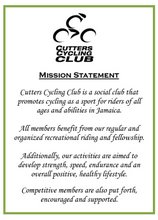skip to main |
skip to sidebar
Group Riding Tips -- Cutter's Tips
 There is no more effective way to become a motivated cyclist than finding a good regular group ride. Here are some group riding techniques common around the world.
There is no more effective way to become a motivated cyclist than finding a good regular group ride. Here are some group riding techniques common around the world. - Pacelines, Pacelines, Pacelines. Single or double, rotating quickly or slowly but always smooth and tight. This is the single overriding feature common to every experienced group ride.
- Accelerate slowly and with an eye to keeping the group together. Attacks, jumps, short-hard pulls and other race-like riding may be fine for certain smaller rides but have no place in a group oriented ride. I'm often surprised that novice riders sometimes think this kind of aggressive riding is better training than a good rotating paceline.
- A consistent pace is key. Try establishing a pedaling rhythm before reaching the front, and maintain it until just after pulling off. If you're feeling especially strong accelerate and/or take a longer pull but if you do increase the pace do it gradually. Don't forget to pedal harder on descents to make up for the extra aerodynamic resistance.
- Go hard on the hills (and elsewhere) but don't forget to regroup. This doesn't mean waiting for every last straggler but always make a reasonable effort to regroup after the harder sections.
- Wheelsitters are always welcome, but please stay at the back. There's nothing more disruptive than someone who rotates to the front only to slow down on hitting the wind. If you're feeling extended, tired, or otherwise not inclined to pull through there's no problem with sitting at the back, just let the riders who are rotating know when they've reached the back of the rotating section.
- Don't open gaps! If you find yourself behind a gap close it slowly. A skilled group will remain in a tight paceline through 95% of an average ride including stops, corners, short climbs, descents, and traffic by closing the inevitable gaps before they become problems.
- Don't point out every single pothole, oncoming car, or other obstacle. Each rider has to take responsibility for themselves. This means that everyone should be paying attention to the traffic and the road, even at the back. The frontmost riders should point out unusual hazards of course, and steer the group gradually around glass, potholes, slower riders and such but don't ever assume that you can leave it up to the other riders to watch the road ahead.
- The lead riders are most responsible for the group's behavior and must take this into account at stop signs and lights. Don't accelerate through a yellow light unless you know the back of the group can make it too. If the group does get split ride slow until the rear group has caught back on. If you're at the back please don't run the intersection just to maintain contact unless it is clear that traffic is waiting for the entire group to pass.
- Don't accommodate elitist attitudes. Perhaps the best thing about good group rides, aside from training, is socializing. Team affiliation, racing experience, helmet use, type of bicycle, etc. are all matters of individual preference and should be left as such. As long as the rider is safe and able to keep up they should be welcome.
- Experienced riders should point out mistakes. This must be done diplomatically of course but it is important to make people aware of unsafe riding, hard braking, cutting blind corners, unnecessarily obstructing traffic, etc.
- It's also helpful to meet at a popular, central location. Cafes, plazas, and bike shops are all good places to wait and talk before the ride starts.
 There is no more effective way to become a motivated cyclist than finding a good regular group ride. Here are some group riding techniques common around the world.
There is no more effective way to become a motivated cyclist than finding a good regular group ride. Here are some group riding techniques common around the world.


No comments:
Post a Comment